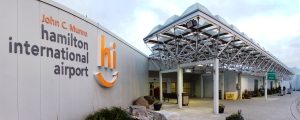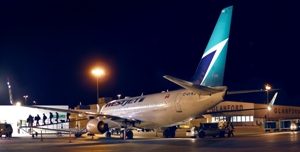Toronto-Hamilton International Airport holds a unique position within Canada’s airport fraternity as it is the only privately owned and operated airport in the country and is part of the leading airport management company Vancouver Airport Services’ (YVRAS) portfolio. Having taken the airport from generating an operating loss of CAD$1 million loss when it took over in 1996, the airport now generates annual profits at no cost to the tax payer. Employees at the airport and surrounding businesses have risen from 300 to 3,000 since the lease began. Chief Executive Officer Richard Koroscil and his management team have pledged to continue to develop all aspects of the business and are particularly focused on developing the dual revenue streams from increased passenger numbers and freight services. The goal is to position Toronto-Hamilton as the low-cost gateway to the Southern Ontario region by creating routes attractive to a highly populated catchment area and integrating growth with planned regional economic developments. The airport has already achieved great progress with its status confirmed as the largest (by volume) multimodal cargo facility in Canada; and has determined plans to increase passenger numbers from a modest 380 000 in 2010 to over 2 million by 2020.
Chief Executive Officer Richard Koroscil and his management team have pledged to continue to develop all aspects of the business and are particularly focused on developing the dual revenue streams from increased passenger numbers and freight services. The goal is to position Toronto-Hamilton as the low-cost gateway to the Southern Ontario region by creating routes attractive to a highly populated catchment area and integrating growth with planned regional economic developments. The airport has already achieved great progress with its status confirmed as the largest (by volume) multimodal cargo facility in Canada; and has determined plans to increase passenger numbers from a modest 380 000 in 2010 to over 2 million by 2020.
The airport offers a number of key features which are attracting carriers looking for a convenient, cost-effective and comfortable airport that will lead straight into the heart of Southern Ontario’s Golden Horseshoe area.
Speaking to The HUB ahead of World Routes, Karen Medweth, Director of Air Service Development and Marketing, Toronto-Hamilton International Airport said: “We can provide a unique combination of benefits. Hamilton is open 24/7, 365 days a year and is uncongested with huge capacity for growth. We’ve maintained a pricing structure that is more cost-effective than our nearest neighbour Toronto-Pearson where landing fees are considerably higher. The excellent road connectivity leads directly to the national highway network. Altogether this makes a very attractive package for airlines, freight and businesses looking to develop a presence in the region.”
Around $165 million has already been invested on projects including a runway extension to accommodate wide-body aircraft up to 747-400s and installation of CAT II ILS to increase accessibility and reliability in inclement weather. Currently Toronto-Hamilton offers scheduled and charter aviation services to eleven non-stop destinations and provides connection options to over 30 cities. New routes are constantly being added. This year has seen low-fare carrier WestJet Airlines, the leading carrier at the airport, announced a brand new route from Hamilton to Las Vegas which joins existing winter routes to Calgary, Cancun, Punta Cana and Orlando along with WestJet’s summer destinations of Calgary, Edmonton, Halifax, Moncton and Winnipeg.
Currently Toronto-Hamilton offers scheduled and charter aviation services to eleven non-stop destinations and provides connection options to over 30 cities. New routes are constantly being added. This year has seen low-fare carrier WestJet Airlines, the leading carrier at the airport, announced a brand new route from Hamilton to Las Vegas which joins existing winter routes to Calgary, Cancun, Punta Cana and Orlando along with WestJet’s summer destinations of Calgary, Edmonton, Halifax, Moncton and Winnipeg.
Hola Sun the specialist Cuban tour operator also announced its second year of winter flights from Hamilton to Holguin and Varadero, Cuba. In addition it will also provide a new schedule to Cayo Santa Maria which serves the island chain of Los Jardines del Rey in the north of Cuba.
Toronto-Hamilton is in ongoing discussions with a number of other operators that are also planning to operate new routes from the airport. The quiet terminal, the un-congested roadways, the reasonable parking prices and the speedy transit time through the airport are all drivers for the new business. “These routes are a great example of the airlines and airport working together to bring the most requested destinations to Hamilton International. It perfectly reflects the airport’s continued commitment to meet the needs of our catchment area,” said Medweth. As one of the most densely populated areas in the North Americas, Toronto-Hamilton offers huge potential for airlines. The current terminal footprint can handle up to 1.5 million passengers annually so it still has considerable capacity for growth. Plans and permissions to operate are also in place for a terminal that could handle five million passengers. Once built the new terminal will feature the introduction of boarding bridges, increased wide-body capability and will continue to support the quick passenger transit times, and fast aircraft turn arounds that Toronto-Hamilton offers today.
As one of the most densely populated areas in the North Americas, Toronto-Hamilton offers huge potential for airlines. The current terminal footprint can handle up to 1.5 million passengers annually so it still has considerable capacity for growth. Plans and permissions to operate are also in place for a terminal that could handle five million passengers. Once built the new terminal will feature the introduction of boarding bridges, increased wide-body capability and will continue to support the quick passenger transit times, and fast aircraft turn arounds that Toronto-Hamilton offers today.
This is also good news for airlines wanting to fly in from Europe. The airport currently offers 13 stands, one with wide-body capability which along with the planned development Medweth anticipates will attract a number of transatlantic international services. “FlyGlobespan, ran a successful UK to Toronto-Hamilton route and experienced an average of over 80 per cent load factor. The airline also had five more routes planned here, so we know the demand exists. Toronto-Hamilton really is the ideal airport for European transatlantic carriers wanting to fly to this part of Canada and we are already in discussions with a number of operators.”
Medweth is also focusing on generating increased business passenger interest. The airport has been working with the City of Hamilton on an innovative land development project - the Airport Employment Growth District (AEGD), for which the airport would be the anchor tenant. An increasing number of international corporations are based in the region, including Fox 40, which produces the pea-less whistle, food conglomerate ED Smith and steel manufacturer Arcelor-Mittel, and more are expected to join them when the AEGD is opened.
The complete area consists of 830 hectares and will create some 30,000 jobs. Existing heavy industry is likely to be joined by future tenants consisting of hybrid prestige and light industrial business including logistics, transport companies and customs brokers. “We expect that the new AEGD tenants will demand easy transport and regular flights not just to other Canadian cities like Ottawa or Montreal, but to key business destinations such as New York, Boston and Chicago. Regular regional shuttles would bring real added value for them.”
 In 2010 Toronto-Hamilton’s cargo handling figures increased by 14 per cent compared with 2009 and ad-hoc cargo flights increased by 33.8 per cent year-on-year. The airport has already been successful in attracting the major package integrators with tenants including leading companies such as Purolator, which handles the express service for Canada Post; DHL which transferred its trans-border services to Toronto-Hamilton in 2009; UPS which has a full sorting facility and Cargojet, which acts on behalf of a number of third party operators. Purolator’s business has developed so significantly it is now pouring several million dollars into creating a greater apron area allowing more DC10s to operate at the airport at once.
In 2010 Toronto-Hamilton’s cargo handling figures increased by 14 per cent compared with 2009 and ad-hoc cargo flights increased by 33.8 per cent year-on-year. The airport has already been successful in attracting the major package integrators with tenants including leading companies such as Purolator, which handles the express service for Canada Post; DHL which transferred its trans-border services to Toronto-Hamilton in 2009; UPS which has a full sorting facility and Cargojet, which acts on behalf of a number of third party operators. Purolator’s business has developed so significantly it is now pouring several million dollars into creating a greater apron area allowing more DC10s to operate at the airport at once.
“Much of the current cargo activity is focused on distributing small packages as a result of the presence of the main consolidators but we plan to grow the larger freight movements through infrastructure investment in a 60,000sq ft, multi-tenant, cross-dock cargo facility,” said Medweth. The development is anticipated to support cargo volumes of in excess of 500,000 tonnes by 2020.





